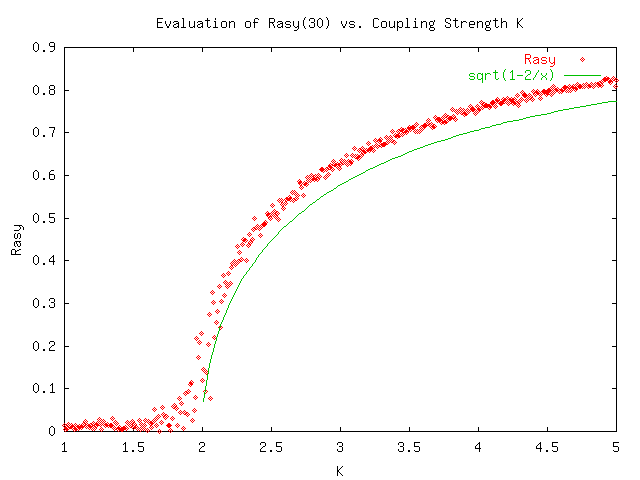
Answer for Final Exam Part 2
The critical coupling strength was estimated by examining the plot of Rasy(30) vs K in the graph below. It was around the expected value of 2. The shape of the function is compared to sqrt(K-2) and proved to match closely.

#include <iostream> #include <math.h> const int pi = acos(-1);
int main(int argc, char* argv[])
{
const double K_MIN = 1;
const double K_MAX =5;
const double K_INC = 0.01;
double k;
const double T_MAX = 30; const double T_INC = 0.01; double t =0; double h = T_INC; double h2= h/2, h6 = h/6;
double sinV, cosV;
const int N = 10000; const int w0 = 2; int i;
double w[N], theta_rand[N], theta[N], dydt[N], thetaMid[N], thetaMidDeriv[N], thetaMidDeriv2[N], theta1Deriv[N];
for (k = K_MIN; k < K_MAX; k+=K_INC)
{
double r, psi=0;
double kr = k*r;
t = 0;
//generate lorentzian distribution for initial omega's
//and set the initial phase's to be a random distribution form 0 to 2pi
//calculate the inital time derivative of theta (dydt)
for (i = 0; i < N; i++)
{
//cout << i << "\t" << 2+ tan(pi*(((double)rand())/RAND_MAX - 0.5)) << endl;
w[i] = w0+ tan(pi*(((double)rand())/RAND_MAX - 0.5)) ;
theta[i] = 2*pi*(((double)rand())/RAND_MAX);
}
//perform rk4 approximation
do
{
//calculate the mean radius and angle of the oscillators
for (i=0, psi=0, sinV=0, cosV=0;i<N;i++)
{
psi += theta[i];
sinV += sin(theta[i]);
cosV += cos(theta[i]);
}
r = sqrt(sinV*sinV + cosV*cosV)/N;
psi /= N;
kr = k*r;
//estimate theta at time t+h/2 from derivative at time t
for (i=0; i < N; i++)
{
//calculate initial dydt (y = theta)
dydt[i] = w[i] + kr*sin(psi - theta[i]);
//calculate theta at the midpoint using initial dydt thetaMid[i] = theta[i] + h2*dydt[i]; //calculate derivative at time t+h/2 thetaMidDeriv[i] = w[i] +kr*sin(psi-thetaMid[i]);
//calculate 2nd thetaMid from thetaMidDeriv thetaMid[i] = theta[i] + h2*thetaMidDeriv[i]; //calculate new thetaMidDeriv using thetaMid calculated by first approximation at time t+h/2 thetaMidDeriv2[i] = w[i] + kr*sin(psi - thetaMid[i]);
//calculate final theta at t+h using 2nd thetaMidDeriv2 thetaMid[i] = theta[i] + h*thetaMidDeriv2[i]; //calculate derivative at time t+h theta1Deriv[i] = w[i] + kr*sin(psi - thetaMid[i]);
//use rk4 to estimate the final theta using a linear combination of previous calculations theta[i] += h6*(dydt[i] + 2*thetaMidDeriv[i] + 2*thetaMidDeriv2[i] + theta1Deriv[i]); }
//plot the convergence of phase magnitude r versus time for a given k //calculate the mean radius of the phase //cout << "\t" << k << "\t" << t << "\t" << r << "\t" << psi << endl;
} while ((t += T_INC) < T_MAX);
//calculate the mean radius of the phase cout << k << "\t" << r << endl; }
return 0; }